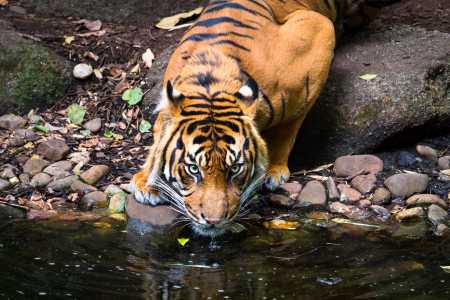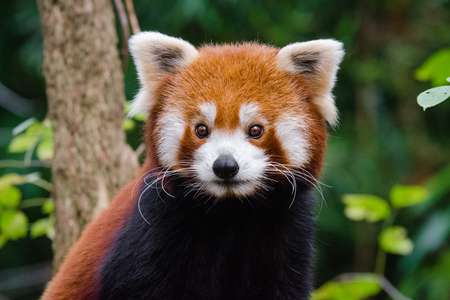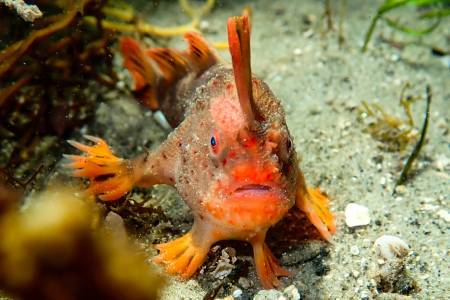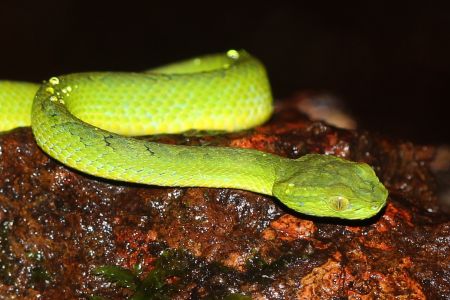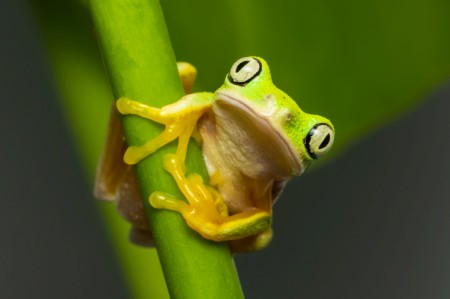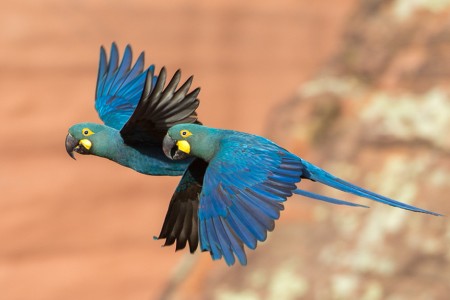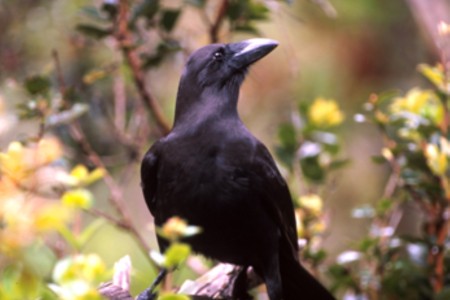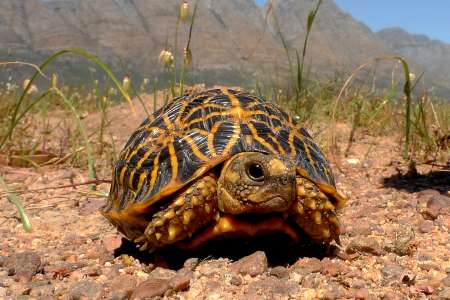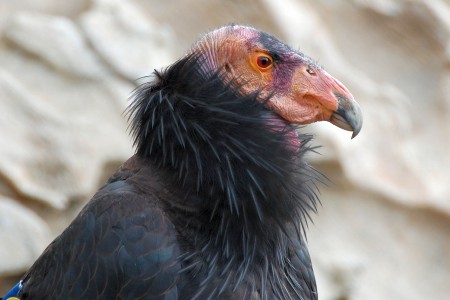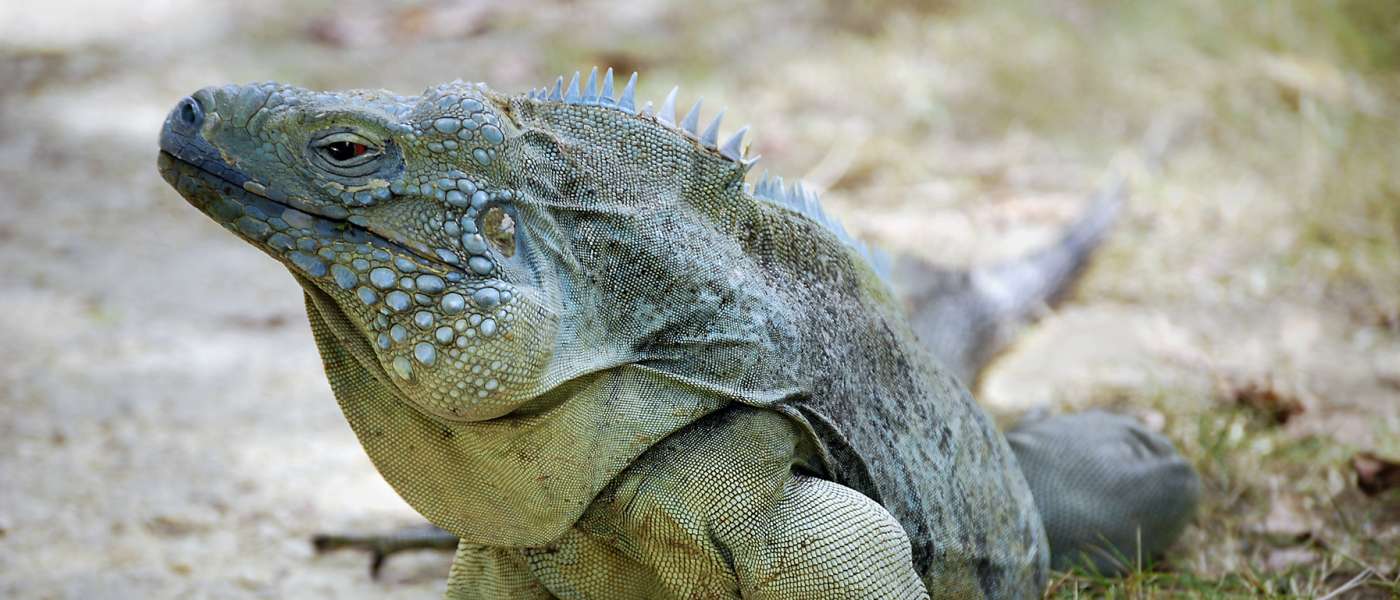
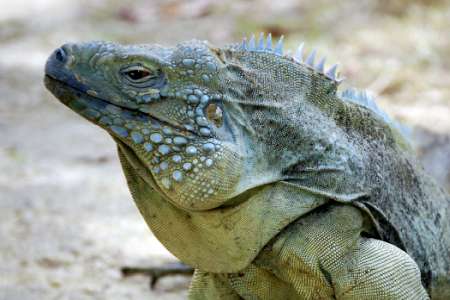
Grand Cayman Blue Iguana
Conservation Has Helped Them Back

INTRODUCTION
The Grand Cayman Blue Iguana (Cyclura lewisi), known as the Cayman Islands rock iguana or the Grand Cayman ground iguana, is endemic to Grand Cayman Islands in the Caribbean. A huge reptile species with striking blue skin, it is one of the most visually striking lizards in the world.
Scientific Classification
• Kingdom: Animalia
• Phylum: Chordata
• Class: Reptilia
• Order: Squamata
• Family: Iguanidae
• Genus: Cyclura
• Species: C. lewisi
Appearance and Behavior
The Grand Cayman Blue Iguana stands out with its distinctive blue hue, which becomes even more vivid when basking in the sun or asserting dominance. Adults can grow up to 5 feet (1.5 meters) from nose to tail, showcasing lean, muscular bodies. They have spiny dorsal crests that extend from the neck to the base of their long tails. They weigh over 25 pounds (11.3 kilograms) and are among the heaviest iguana species. Their faces are marked by reddish-brown eyes and contrasting dark patterns against their predominantly blue skin. However, their color can range from gray-blue to bright azure based on the individual and varying factors like mood or environment.
Male iguanas display more pronounced coloration, transitioning between dark grey and turquoise. In contrast, females lean towards olive green to pale blue shades.
Being diurnal, blue iguanas are most active during daylight. Mornings are typically spent sunbathing. They also spend much of the day foraging and occasionally seeking mates or further sunbathing opportunities. They often retreat to shaded areas or burrows to avoid the intense midday heat.
A unique behavioral trait of these iguanas is their use of “head-bobs” and other gestures to convey messages to their peers. This can mean greetings, warnings, territorial claims, or romantic intentions, depending on the situation.
Habitat and Ecology
The Grand Cayman Blue Iguana is native to Grand Cayman and inhabits its rocky, sunlit, semi-deciduous forests, scrub woodlands, and dry-to-subtropical forests. Their lifespan typically ranges from 25 to 40 years in the wild, though a notable male specimen in a U.S. zoo lived past 69 years in captivity. While their primary diet consists of leaves, fruits, and flowers, they occasionally indulge in small invertebrates, fungi, or even soil.
Being oviparous, female blue iguanas lay egg clutches ranging from 1 to 22 eggs, with the average clutch size being about 15 eggs. Once the eggs are laid, the female buries them in the soil. The ensuing incubation period spans roughly 65 to 90 days, throughout which the female diligently guards her nest. An intriguing aspect of their reproduction is the temperature-dependent sex determination (TSD). Unlike humans, where sex is genetically determined, the gender of blue iguana hatchlings is decided by the incubation temperature during a pivotal period of their embryonic development. Depending on this temperature, the offspring will emerge as either male or female.
Conservation Status
The Grand Cayman Blue Iguana is a unique species but faces significant threats from habitat loss, climate change, diseases, road casualties, predation, and competition. Efforts have been made to protect and increase its population, but the Blue Iguana remains endangered. Conservation initiatives, such as captive breeding and habitat restoration, have been implemented to help secure its future.
THREATS TO GRAND CAYMAN BLUE IGUANAS

Despite hard-won success in conserving the species, the once vibrant population of the Grand Cayman Blue Iguana still faces a dangerous path toward extinction. The urgent need to preserve this unique creature calls for continued attention.
Habitat loss
The blue iguana’s natural habitat is the dry shrublands and forests of Grand Cayman Island. These habitats are being lost and fragmented due to human activities, including:
- Development: Grand Cayman Island is a popular tourist destination, and there has been a lot of development on the island in recent years. This development has led to the loss of many blue iguana habitats.
- Agriculture: Grand Cayman Island is also a major agricultural producer, and agricultural land is expanding. This expansion is also leading to the loss of blue iguana habitat.
- Infrastructure: The construction of roads, bridges, and other infrastructure also contributes to the loss of blue iguana habitat.
The invasive Green Iguana, introduced to the Cayman Islands, competes for resources and the shrinking habitat, further exacerbating the survival of the Blue Iguana.
Habitat loss is the largest threat the blue iguana faces because it makes it difficult for the iguanas to find food, mates, and safe places to lay their eggs. When the habitat is fragmented, it also makes it easier for predators to reach the iguanas.
Predation and Competition
The predator threat primarily stems from feral cats and dogs that are not originally native to the islands. Brought by human settlers to the Grand Cayman Islands, these feral animals have created a new dynamic in the ecosystem. The voracious predatory behaviors of these feral animals directly threaten the Blue Iguanas, particularly targeting their vulnerable eggs and juvenile members. These predators can easily overcome the defenseless iguanas. Human introduction of these new predatory elements into the ecosystem has disrupted the delicate balance that the iguanas need for survival.
A close relative – the invasive Green Iguanas, originally native to Central and South America- have established themselves firmly in the Grand Cayman islands. With no natural predators, their numbers have surged, leading to great competition between the Blue and Green Iguanas for resources. This competition encompasses essential resources like food and nesting sites, critical for the Blue Iguanas’ survival and reproduction. It is a fight they seem to be losing due to the latter’s increasing numbers, further threatening the species.
Climate Change
- Temperature Variations: Reptiles such as the Blue Iguana are ectothermic, which means they depend on the external environment to regulate their body temperature. Significant temperature changes could impact their ability to regulate body temperature, reproduce, and even survive.
- Sea Level Rise: Rising sea levels, a consequence of climate change, significantly threaten the Blue Iguana’s habitat. Much of the Grand Cayman’s land area is low-lying and could be submerged if sea levels continue to rise.
- Increased Storm Frequency and Intensity: Climate change increases the frequency and intensity of extreme weather events like hurricanes. These can devastate the Blue Iguana’s habitat, affecting both food availability and shelter.
- Drought: Changes in rainfall patterns could lead to extended periods of drought. Drought conditions could reduce the availability of food and water for the Blue Iguana.
- Shifts in Vegetation: Changes in climate can cause shifts in vegetation types over time. If the kinds of plants the Blue Iguana relies on for food or shelter become less common in their habitat, the iguanas could struggle to find the resources they need to survive.
Diseases
The Blue Iguana’s vulnerability to various diseases significantly affects its survival. One concern is the occurrence of metabolic bone disease, which is closely associated with an improper diet. This condition results in a weakened skeletal structure, impacting the iguana’s quality of life and overall survival prospects.
Simultaneously, the Blue Iguana also grapples with internal parasites, such as ticks and worms, that pose an ongoing challenge to its health and longevity. These parasites can lead to malnutrition and disease transmission. Bacterial and viral infections, such as Pseudomonas and Salmonella bacteria, can lead to severe infections with potentially fatal implications if left untreated. The Iguanid herpesvirus also presents a significant risk, often leading to systemic infection and, in severe cases, death.
These threats are compounded by the shrinking population of Blue Iguana and the decline in genetic diversity. Factors that leave them more susceptible to disease.
Road Mortality
Being slow-moving creatures, Blue Iguanas are victims of road accidents. Some by people who cruelly kill Blue Iguanas by deliberately swerving to run them over. As urban development continues encroaching upon their natural habitats, the likelihood of such incidents increases, contributing to their declining numbers.
In conclusion, the Grand Cayman Blue Iguana faces many threats that place its survival in peril. These challenges span from extensive habitat loss to devastating diseases.
IMPORTANCE OF GRAND CAYMAN BLUE IGUANAS
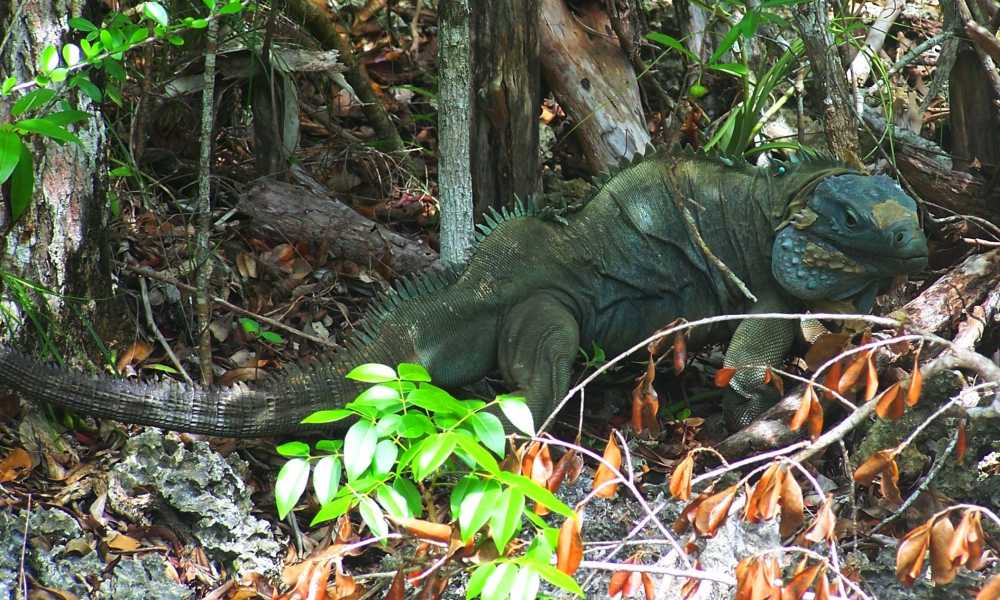
Financial Impacts of Grand Cayman Blue Iguana Decline
The Grand Cayman Blue Iguana plays a critical role in its ecosystem, including seed dispersal, which supports the diversity and regeneration of local plant species. This balance is threatened by the species’ decline, resulting in expensive ecological restoration and management endeavors.
This species is more than just a unique reptile; it is one that, in 2002, was functionally extinct, with only 12 left in the wild. Those declining numbers sounded alarm bells on the island and globally, with real financial implications for citizens worldwide. Although hard figure totals are not available, estimates are that millions have been spent on conservation projects for this species.
These costs, often borne by international organizations and governments, are partially financed by taxpayers in developed countries. They extend from conducting scientific studies to implementing and enforcing protective measures.
Impacts on Local Ecosystems
The Blue Iguana, like every species, provides unique ecosystem services and plays a critical role in maintaining ecological balance. Specifically, Blue Iguanas contribute to nutrient cycling through feeding and excretion habits. They are herbivores, feeding on various fruits, flowers, and leaves, and through their diet, they facilitate seed dispersal for many plant species. This creates plant propagation and enhances a service that other plant-eating species depend on.
The iguanas are prey for several native and non-native predators, including birds of prey, snakes, and feral mammals. One worry for a new hatchling is the native snake Alsophis, which loves a meal of frogs, lizards, or baby iguanas. Iguana hatchlings climb trees to avoid them. Loss of the iguana would force predators such as this snake to switch to other prey, leading to imbalances in the food chain or even facing extinction.
Their burrows are also used by other species, serving as shelters and breeding grounds.
A healthy population of Blue Iguanas contributes to the robustness and resilience of the ecosystem, enabling it to recover from various disturbances. Losing the Blue Iguanas would thus reduce the ecosystem’s overall resilience, potentially leading to further biodiversity loss and ecosystem degradation.
Effects on Climate Change and Associated Costs
The Blue Iguana, like other species that disperse seeds, plays a role in carbon sequestration, indirectly contributing to climate change mitigation. If this species disappears, the ecosystem’s capacity to absorb carbon dioxide will be reduced, amplifying climate change impacts.
Given the severity of the ongoing climate crisis, the loss of any species that helps mitigate climate change and restore ecological balance is a serious concern. Efforts to reduce carbon emissions by restoring damaged habitats and rebuilding biodiversity come with significant costs.
Costs of Legislation and Enforcement
Implementing protective measures, such as legislative initiatives and policies for endangered species like the Blue Iguana, requires substantial funding to ensure effective enforcement, monitoring, and compliance. The projected losses of up to a million species underscore the urgency to prevent extinction and conserve biodiversity. While the costs of protecting the Grand Cayman Blue Iguana are a tiny part of the costs to governments worldwide of providing protection and mitigation of all species, it is costly, and the costs are growing. When totaled, these worldwide costs add very high pressures on budgets and fund allocation and must be provided by taxpayers.
Loss of Ecotourism Potential
With its striking blue color and unique behavior, the Grand Cayman Blue Iguana holds considerable ecotourism potential. The decline or possible extinction of this species would result in lost opportunities for ecotourism, affecting local communities that could benefit from tourism revenue.
Ecotourism frequently supplies the essential financial support required for conservation efforts. Tourists willing to pay for the unique experience of seeing the Blue Iguana in its natural habitat indirectly contribute to its conservation by generating funds. An extinction scenario would result in lost tourism revenues and diminished funding for local conservation initiatives.
The Bottom Line for the Blue Iguana
This striking reptile is more than just a species on the brink of extinction. Its rescue from that decline has far-reaching implications for global economies, and its role in biodiversity and climate change mitigation underscores the importance of its conservation. While protecting biodiversity comes at a cost, losing this and other species is significantly higher.
HOW TO HELP GRAND CAYMAN BLUE IGUANAS
Individual efforts hold a significant place in biodiversity conservation, but the problems faced by unique species like the Cayman Island Blue Iguana require a broader scope of action. Like many others, this species faces challenges from local issues, such as habitat loss and global concerns, including climate change, pollution, and the broad loss of biodiversity. To address these challenges, we must work together, rallying effective leadership to participate in and promote global solutions. Leaders who embrace the need to defeat global climate change and pollution and keep our planet healthy are key to the survival of all species, including us.
Community Involvement and Education
Those who live locally to the iguanas play a vital role in conservation efforts. If not aware of the issues, local populations education programs that teach about the ecological significance of the Cayman Island Blue Iguana, its threats, and, importantly, how helping the species gain protection also benefits their society. Educational programs and workshops can help foster and increase a sense of responsibility and ownership. All of these factors have had significant impacts on iguana conservation.
Supporting Ethical Ecotourism
Ethical ecotourism is a potential lifeline that can greatly contribute to the survival and conservation of the Cayman Island Blue Iguana while also benefitting local communities. When tourists consciously opt for low-impact tours emphasizing respect for local ecosystems and wildlife, they actively support conservation efforts. These actions promote awareness about the Blue Iguana’s situation and bring green money into local economies. When managed with a clear focus on conservation, these tourism revenues can significantly boost efforts to protect and restore the iguana’s dwindling natural habitat. People worldwide can join hands with local communities to make a real difference for the Blue Iguana and the rich biodiversity it represents.
Combatting Illegal Pet Trade
The illegal pet trade is not a substantial threat to the Blue Iguana it once was. Yet, refusing to purchase wildlife illegally, especially threatened species like the Blue Iguana, can help combat this illicit trade. Advocacy for stricter laws and harsher penalties against wildlife trafficking can also be a crucial step toward protection.
Supporting Conservation Organizations
Numerous non-profit organizations, such as the Blue Iguana Recovery Program, are championing the cause of Blue Iguana conservation. The Recovery Program actively engages in several strategies, including habitat protection, captive population breeding, and reintroducing healthy individuals back into the wild. The organization is not limited to direct intervention but also heavily emphasizes raising public awareness about the Blue Iguana’s plight. By supporting these initiatives through volunteering, financial donations, or even raising awareness within your circles, you can play a significant part in ensuring the survival of this unique species.
Reducing Environmental Impact
The Blue Iguana, like many other species, is significantly affected by climate change. Changes in climate patterns can negatively impact their habitats and food sources. By minimizing waste, choosing renewable energy sources, and adopting sustainable diets, all of us can help reduce our carbon footprint and, thus, indirectly aid in the conservation of the Blue Iguana and defeat global climate change that is making the Earth hostile to us and the other species.
Appreciate Biodiversity and Join Citizen Science Projects
Acknowledging the interconnectedness of species is vital to conservation. The decline of the Blue Iguana not only impacts the species itself but also affects its ecosystem. By learning about global biodiversity and each species’ role in maintaining ecosystem balance, individuals can better understand the critical need for conservation.
Participation in citizen science projects that aim to monitor and protect biodiversity can provide crucial data to researchers. This information can help track population changes in species like the Blue Iguana and guide future conservation efforts.
Conclusion
Ensuring the survival of the Blue Iguana demands a collaborative approach. This encompasses bolstering community awareness, endorsing sustainable tourism, minimizing our ecological footprint, and advocating for impactful legislation. Crucially, we must elect leaders with a genuine commitment to the well-being of our planet. By actively participating in these endeavors, we support the preservation of Blue Iguana and the broader mission of safeguarding our planet’s rich biodiversity and habitability.


